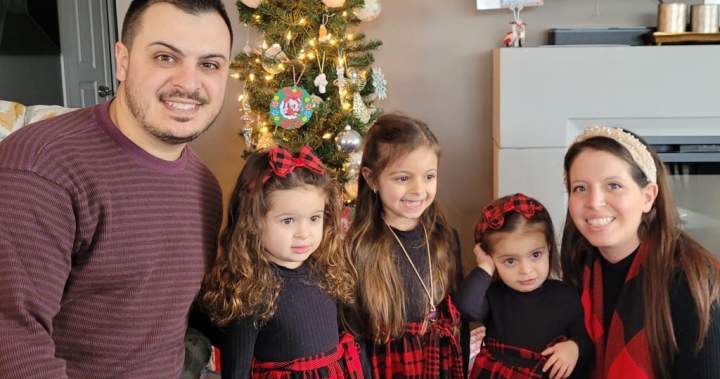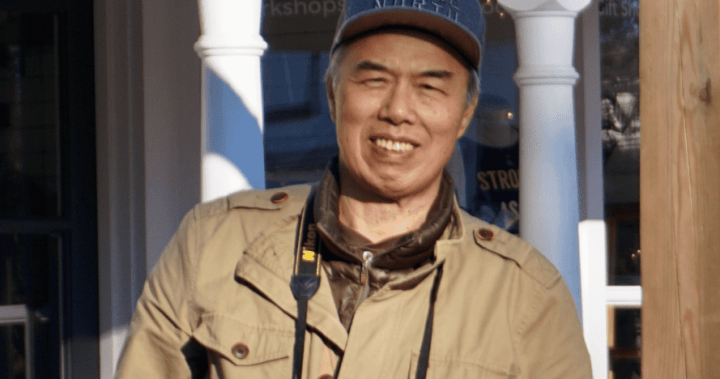Family of Ontario father killed by alleged dangerous driver calls for tougher laws

The family of an Ontario father of three killed earlier this month by an alleged dangerous driver, who was already facing charges in a collision involving the premier, is trying to channel some of their grief and pain into pushing for stronger laws.
Andrew Cristillo, 35, was killed Aug. 3 in a head-on crash in Whitchurch-Stouffville that also left his wife and their three young daughters injured.
It should not have happened, said his brother Jordan Cristillo, and he does not want other people to suffer through the same nightmare.
“When you see every weekend, (headlines like) ‘One dead, two injured,’ these are people’s families that get torn apart and flipped upside down, and we just happen to be one of them,” Cristillo said in a recent interview.
“So now I want to turn this pain into purpose and try to – in honour of my brother, but also in honour of all those other families that are impacted — put an end to this, because if you have dangerous drivers back on the road, you’re just gambling with other people’s lives.”
The three girls are recovering from various physical injuries, but emotionally and spiritually they have a long road ahead, said Cristillo. All three were under the age of seven at the time of the crash, but in the few short weeks since then, two of them have had to mark birthdays without their beloved father.
“I’m confident that they’ll continue to (physically) heal and move forward, but it’s more of the life milestones of looking out when you’re doing a recital and not seeing your father in the crowd, or walking down an aisle, and not having your father to walk you down that aisle,” Cristillo said.
“That’s a life-long sentence that this family has now.”
The family has launched a petition calling for Andrew’s Law, listing ways they want to see dangerous driving penalties strengthened.

Get breaking National news
For news impacting Canada and around the world, sign up for breaking news alerts delivered directly to you when they happen.
“The first change we’d like to see is, if you’re being charged with dangerous driving, your licence is revoked until you go through your trial, so that we prevent and protect others on the road from dangerous drivers,” Cristillo said.
As well, there should be lifetime driving bans for people convicted of extreme dangerous driving, Cristillo said.
“I don’t know how many more lives need to be ripped apart and families torn apart for the government really to take this seriously,” he said. “If you know you have people that can’t be trusted behind a wheel, don’t allow them, because driving is a privilege. It’s not a right.”
Jaiwin Kirubananthan, 18, was charged with dangerous driving causing death, three counts of dangerous driving causing bodily harm, failing to remain at an accident resulting in death and public mischief in the crash that killed Andrew Cristillo. He is expected to appear in an Oshawa, Ont., court Monday morning.
Police say Kirubananthan is the same person charged after a car hit an Ontario Provincial Police vehicle Premier Doug Ford was travelling in on Highway 401 in January.
Kirubananthan’s lawyer could not comment on the circumstances of either case, but said he believes the dangerous driving laws are sufficient.
“The maximum penalty for dangerous driving causing death is life in prison,” Barry Fox said in an interview. “Can’t get much more drastic or draconian than that.”
There are degrees of dangerous driving, Fox said, and the law already recognizes that with a wide range of possible punishments. When an accused gets released on bail they may have a driving prohibition attached, Fox said, but it isn’t mandatory.
“There has to be room within the ambit of the law to accommodate different types of dangerous driving,” he said. “We just can’t take a hammer and say, ‘You’re off the road for two years (or) five years.”
Ford was asked at a news conference earlier this month if he would support strengthening penalties and said he agrees “absolutely.”
“I think it’s long overdue, so we’ll look at it,” Ford said.
The federal Justice Department can’t comment on the case while it’s before the courts, a spokesperson said, noting that laws around impaired and dangerous driving were strengthened in 2018.
“Among other changes, the penalty for dangerous driving causing death was increased to a maximum penalty of life imprisonment, which is the highest maximum term of imprisonment provided by law,” Katelyn Moores said in a statement.
People who are convicted of dangerous driving causing death can also receive an order prohibiting them from driving for life, Moores said, adding that the government is “always looking at ways to improve the criminal justice system and to ensure the safety of our roads and highways.”
Ford has called for people across Ontario to support the Cristillo family. Not only have they lost a father, but his wife Christina has been battling breast cancer for the past few years.
“That whole uncertainty hasn’t gone away,” Jordan Cristillo said. “We never imagined that my brother wouldn’t be there with her along each of these steps. So it’s hard to fathom how she feels having to face that uncertainty, but also to not have her best friend and partner, who make her laugh during all the appointments, by her side to get through it.”
Cristillo said Christina’s cancer diagnosis made his brother determined to create fun, life-long memories as a family. He was always taking his kids on adventures and being present as a hands-on father, Cristillo said. Andrew was the life of the party who always had people in stitches, he said, adding he will miss his brother’s pranks and at-times inappropriate jokes.
Friends and strangers alike have resoundingly responded to a family GoFundMe fundraiser seeking help for medical and other expenses for the girls. More than $500,000 in donations have poured in.
As well, the family’s change.org petition called Implement Andrew’s Law for Safer Roads has garnered more than 10,000 signatures.
“Whether it’s signing a petition or supporting the GoFundMe, all those acts big and small, is really giving our family strength to keep moving forward,” Cristillo said.
“We’re very grateful for the entire community for having our backs.”


The Supreme Court of Canada has declined to hear an appeal of a lower-court ruling that upheld a First Nation’s ownership of a stretch of land at a popular Ontario beach after a lengthy dispute.
Canada’s top court has dismissed the appeal request from landowners and the province after a stretch of land along Sauble Beach was returned to Saugeen First Nation in 2023.

Get breaking National news
For news impacting Canada and around the world, sign up for breaking news alerts delivered directly to you when they happen.
This dismissal comes nearly two months after members of Saugeen First Nation changed the iconic “Welcome to Sauble Beach” sign that greeted beach visitors.
The temporary “Welcome to Saugeen Beach” sign was erected to reflect the First Nation’s ownership of the land, with the town’s mayor expressing disappointment that he wasn’t alerted of the change.
The Ontario Court of Appeal upheld last December the decision that 2.2 kilometres of the coastline in South Bruce Peninsula was incorrectly surveyed 170 years ago.
The portion of the land is valuable fishing ground for the First Nation community and was surrendered in 1854 in an agreement with the Crown to give up portions of Bruce Peninsula.
© 2025 The Canadian Press

The majority of post-secondary students in Ontario are stressed about their finances heading into the school year, a new survey found.
The survey from TD Bank, which collected data from post-secondary students across the country, found that 92 per cent of all respondents in Ontario are stressed about their finances.
“The survey was clear that our students are experiencing a lot of stress, which is a bit unique from previous generations because of the multitude of factors that are just hypersensitive at this point, with higher unemployment, higher cost of living, higher tuition,” says Joe Moghaizel, vice-president of everyday advice journey at TD.
The survey found that while 78 per cent of Ontario parents believe their child has experienced financial stress in the past three months, that figure was well below the actual number of 92 per cent.
“What’s interesting is the amount of pressure and stress that they’re currently facing and feeling, and the disconnect between what their parents believe they’re experiencing,” Moghaizel says. “Parents were not aware of the amount of stress that the students are feeling.”
Moghaizel pointed to a number of things leading to this financial pressure, including the high cost of living and high rate of unemployment among young people in a difficult job market, leading to many students to have what he called a volatile income.

Get breaking National news
For news impacting Canada and around the world, sign up for breaking news alerts delivered directly to you when they happen.
The survey also found that Ontario had the highest percentage of students stressed about tuition costs at 35 per cent, compared with an average of 26 per cent in other provinces.
The government of Canada estimates it will take almost 10 years for the average student to pay off their student loans and the total student loan debt in Canada surpassed $23.5 billion in 2022.
“You go back to over two decades ago, when I was in school, the financial pressures that students deal with now are significantly higher because tuition is a lot more expensive and the cost of living is more expensive, and inflation has really taken a bite at students,” Moghaizel says.
Another key takeaway from the survey was that 36 per cent of all respondents found that social spending stressed them out the most.
Moghaizel says the social pressure speaks to the online environment that students find themselves in today, where everything they do is shared online.
“They all feel the pressure to spend and keep up, which, again, it’s not too dissimilar from other age groups and we’re keeping up with the Joneses and just keeping up with the spending habit of your circle creates a bit of pressure,” he says.
Moghaizel says this can leave post-secondary students feeling ill-equipped to manage their finances better.
Despite the concern, Moghaizel hopes this information is not discouraging to students and is an opportunity to start establishing good financial habits early in life.
He said that with societal pressures, it’s good for students to understand their needs versus their wants, and focus on prioritizing the necessities. Moghaizel says that through tracking their spending, students can see where all of their money is going.
“We want to make sure that we’re equipping students with the right understanding of financial knowledge for the products and services,” Moghaizel says.
© 2025 Global News, a division of Corus Entertainment Inc.

A Canadian man has pleaded guilty to illegally photographing classified U.S. defence facilities at the Space Force military base in Cape Canaveral, Fla.
Xiao Guang Pan, 71, of Brampton, Ont., pleaded guilty to three counts of unlawful photographing of military installations without authorization on three separate days in early January.
A U.S. District Court in Florida judge put Pan on probation for 12 months and immediately ordered him deported to Canada by U.S. Immigration and Citizenship Enforcement (ICE) officers under the U.S. Immigration and Nationality Act, citing his violations of American espionage laws.
Pan did not immediately respond to a request for comment.
A U.S. Department of Justice official was unsure about where Pan is in the ICE deportation process.
Pan’s guilty plea and deportation come as anxiety grows among U.S. lawmakers and ordinary Americans about hundreds of unidentified drones flying over sensitive American military bases amid concerns about foreign surveillance and spying.
A copy of Pan’s plea agreement reveals a stark contrast between what Pan said he was doing in Florida in January, when he was stopped by police, versus what U.S. federal agents actually found on his drone, phone and storage devices after seizing them.
On an artist biography page published by the Brampton Arts Organization, Pan stated he was born in China in 1953, immigrated to Canada in 2001 and has lived in Brampton since 2003.
Pan worked as a Best Buy Canada technician for 18 years until retirement in 2022, the biography adds.
Pan entered U.S. via Detroit
Pan entered the U.S. on a tourist visa at the Ambassador’s Bridge in Detroit, Mich., on or about Nov. 2, 2024. The court documents don’t suggest what Pan was doing or where Pan travelled in November and December.
The retiree was charged by summons on Feb. 11 after the National Aeronautics and Space Administration (NASA) detected drone activity near the Space Force Base and called in law enforcement on Jan. 7.
Brevard County Sheriffs responded. They saw Pan operating a DJI Mavic Pro 3 unmanned drone quadcopter from a parking lot in Port Canaveral and learned he’d been in the area for three days.
The local officers then tipped federal law enforcement agencies.
Federal agents caught the Brampton resident using his powerful unmanned drone and a separate camera with telephoto lenses to photograph and video classified military facilities and equipment near the Space Force base on Jan. 5, 6 and 7, without the base commander’s prior authorization as required under U.S. law.

Get breaking National news
For news impacting Canada and around the world, sign up for breaking news alerts delivered directly to you when they happen.
According to a statement of facts found in the plea agreement, which Pan signed and initialled on every page, U.S. federal agents interviewed him twice – no dates were given – and asked the Canadian what he was doing with the drone.
They also warned him: lying to federal agents is a federal crime in the U.S.
“Pan told the agents that he had flown his drone to take pictures of the beauty of nature, the sunrise, and the cruise ship port. He stated that he had not seen any launch pads and that he did not know that he was near a military installation,” the plea deal states.
Pan voluntarily submitted his devices to U.S. agents for a forensic data extraction.
That’s when the investigators found more than sunrises, nature and cruise ship videos.
The data showed Pan had flown his drone nine times and taken 1,919 photographs and videos during his three-day Florida visit, the plea deal states.
Of those 1,919 photos and videos, 243 photographs and 13 videos showed specific images of Space Force base military infrastructure and launch facilities, including fuel and munitions storage facilities, security checkpoints, and a Navy submarine platform, according to the plea agreement.
On Jan. 6, his second day of flying the drone quadcopter, Pan took nine videos and 166 photographs of Space Force installations.
This time, he launched his drone from a location several miles closer to the base; his photographs and videos captured the same military infrastructure as on Jan. 5, but in higher quality and from different angles, according to the plea agreement.
Pan also captured images and videos of mission control infrastructure and fuel and munitions facilities, including a photograph of a Space Launch Complex and payload processing facilities operated by two defence contractors.
On the third day of his drone flying, and before he was encountered by law enforcement, Pan recorded two more videos and took 56 photos.
Day 3 images included security checkpoints
His Day 3 images and videos showed roads, power distribution infrastructure, security checkpoints, mission control infrastructure, national security space launch infrastructure, fuel and munitions storage, and naval infrastructure, the plea agreement states.
After police stopped Pan on Jan. 7, federal agents interviewed him twice.
During those interviews, Pan was warned that lying to agents is a federal crime. He did so anyway, the plea deal suggests.
In addition to telling agents he flew his drone to record nature, sunrises, and cruise ships and didn’t know he was near a military base, Pan said his drone sends alerts and warnings to his handset and he received no alerts or warnings, the plea deal adds.
Investigators recovered flight log data from Pan’s quadcopter. It showed that on all three days he flew, the drone logged several alerts and sent operator messages about altitude and FAA airspace violations.
On Pan’s cell phone, agents also found several screenshots he created, including several Google Maps satellite overviews of Cape Canaveral. One screenshot taken Jan. 7 while Pan was at his drone launch location, prominently displayed the words “Cape Canaveral Space Force Station.”
Pan surrendered his $5,000 quadcopter
Pan was charged in February after a multi-agency probe led by the U.S. Federal Bureau of Investigation, U.S. Homeland Security, and the U.S. Air Force Office of Special Investigations.
Pan surrendered his $5,000 quadcopter, control equipment and storage devices that housed his videos and photos to the U.S. authorities.
He is also banned from returning to the U.S. without prior consent from the Secretary of the Homeland Security department.

-

 Uncategorized3 months ago
Uncategorized3 months agoShop Proud, Eat Proud, Be Proud — Ottawa Canada Day Market This June 28th
-

 3 months ago
3 months agoCanada’s world junior trial saw juries tossed, intense testimony. Here’s a recap
-

 2 months ago
2 months agoRing of Fire road to bring prosperity to First Nation, problems for caribou: report
-

 2 months ago
2 months agoMeasles circulating in northeastern B.C. community, health officials warn
-

 3 months ago
3 months agoAnishinabek Nation chief says he briefed Ontario police on protests against Bill 5
-

 2 months ago
2 months agoFormer major leaguer, Jays doctor Ron Taylor dies
-

 2 months ago
2 months agoJagmeet Singh apologizes for attending Kendrick Lamar concert after Drake calls him out
-

 2 months ago
2 months agoDreaming of a lakeside cottage but can’t afford it? Co-ownership could open that door







